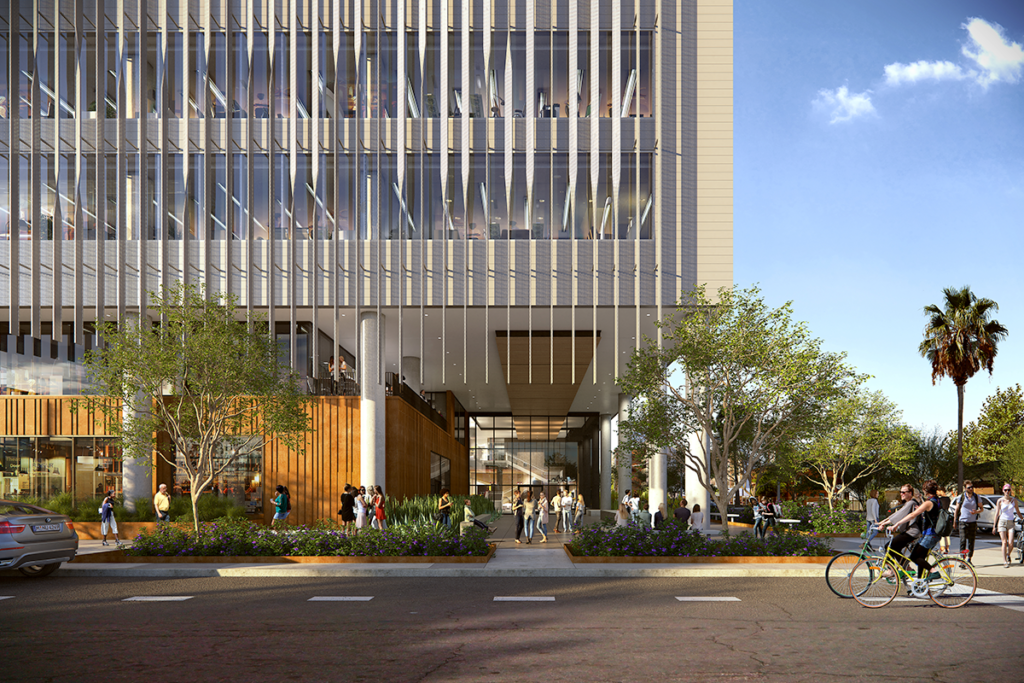
In partnership with Wexford Science + Technology and the City of Phoenix, Arizona State University opened its newest building (PBC1) on the Phoenix Biomedical Campus to promote entrepreneurship and economic development.
Half of this seven-story, 226,000 sq. ft. extension will serve as a significant resource to several ASU colleges, including the Edson College of Nursing, the College of Health Solutions, the College of Liberal Arts and Sciences and others where students and staff can conduct research and clinical studies.
Thomas Osha, the senior vice president of innovation and economic development for Wexford, said that PBC1 will also bring together the two other major Arizona universities, University of Arizona and Northern Arizona University, as well as TGen, Phoenix Union Bioscience High School, Dignity Health Center, Gateway Community College and other biomedical companies.
At the ribbon cutting ceremony on March 30, Osha said it will become a “heart, a nexus” for the Phoenix Biomedical Campus in its future projects in the surrounding communities because of its strategic location right off Roosevelt Row.
“Buildings like this and campuses like this are absolutely critical to recovering stronger than ever and bringing together great research from great university partners, entrepreneurial activity, corporate engagement, and community inclusion … in a singular place,” Osha said. “It’s a unique building in a unique time.”
The main goal of the Wexford building is to discover ways to improve the human condition through clinical research and trials, with all involved organizations working together for a common cause while engaging the community in the process.
PBC1 provides clinical research space, laboratories and conferencing areas. There are no classrooms because the building is designed for students to intern and network with other professionals in their related field.
One of those professionals include Dr. Steve Potts, cofounder and CEO of OncoMyx Therapeutics, a company developed for finding cures to solid cancers and whose ties to ASU run deep. The idea for OncoMyx was based on 30-year old research from former ASU professor, Grant McFadden.
Potts said that the Wexford building is one of a kind and that its contemporary, well-planned setup is perfect for the kind of research that could shape the future of community health.
“In terms of the lab and office balance, it’s hard to find a facility like this, that’s this modern and just built for life science firms,” Potts said. “It’s really well-built for the biotech or life pharma, anyone doing life science.”
The City of Phoenix, represented by Mayor Kate Gallego and District 8’s Councilman Carlos Garcia— whose district this building falls in—was in full support of the property’s construction and purpose from the get-go.
Garcia said that PBC1 is a notable addition to the 30-acre campus, especially during the COVID-19 pandemic.
“At the City of Phoenix, one of our main goals is to assure that the quality of life of all of our residents arise,” Garcia said. “This facility in itself is going to give the opportunity for our folks to come in, be able to use the labs, be able to figure out a broader health risk that might be hurting our communities.”
Deborah Helitzer, dean of the College of Health Solutions, says that the Wexford building is critical to advancing the opportunities for her students to conduct clinical and community translational research, as part of the second floor is dedicated to just that.
Helitzer said that before now, ASU has been involved in basic science, but this establishment would allow them to test new innovative findings that companies bring to the table, and conversely, companies can test the university’s findings too. This creates a seminal intersection between public and private sectors.
“The facility is magnificent. My breath gets taken away when I go in there anytime,” Heltizer said. “It’s a great space for us … and the wonderful benefit is that it’s so huge, we will have the opportunity to have a lot of cross collaborations with other colleges.”
That breathtaking reaction as described by Helitzer might be associated with the time and care put into the interior design, particularly on the first floor of PBC1. The building is riddled with various sculptures and paintings from local artists.
Kyle Jardine, the director of development at Wexford, said that the entire inspiration for the art inside the property was based on the image many people link to Arizona: the saguaro cactus.
“The whole building, the spines, are based off the saguaro cactus,” Jardine said in an Instagram live video with the Phoenix Community Alliance page. “So we kind of played on that blend of life science and the desert coming together.”
A giant hanging glass sculpture, inspired by the DNA makeup of a saguaro cactus hangs in front of the lobby window. As evening glow catches the glass, Jardine said that it creates a sparkle effect that illuminates the entire room, shining light on the building’s progress and innovation that will benefit the city and communities beyond.
PBC1 is just one of many buildings to come in the next five to ten years which will cover the remaining acres of land on the Phoenix Biomedical Campus, expanding the reach of new methods to improve overall community health.
Contact the reporter at [email protected].
